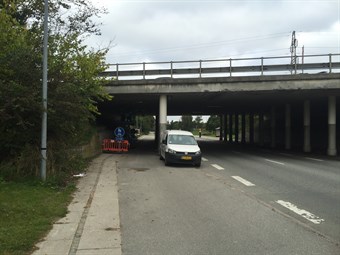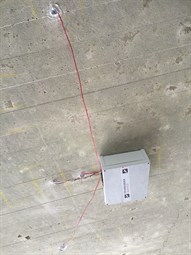Automatic surveillance system for detection of alkali-silica reactions
Danish Technological
Institute has developed an automatic surveillance system that
potentially can detect ongoing alkali-silica reactions at an early
state and thus reduce the damage caused by the chemical reaction.
The surveillance system is currently being tested in a
full-scale setup on a highway concrete bridge located in
Vallensbæk, Denmark (Figure 1).


Figure 1. A surveillance system
for detection of ongoing alkali-silica reactions in concrete
structures is currently being tested on a Danish highway bridge
(picture on the left). The installed datalogger is seen in the
picture to the right.
Alkali-silica reaction is a
reaction, which over time causes expansion of aggregates contained
in concrete and subsequently can result in severe cracking of
structures made of such concrete. A highly alkaline cement paste,
reactive silica aggregates and sufficient moisture must be present
in the concrete structure to trigger the chemical reaction. In
Denmark as well as in other countries worldwide old existing
bridges that are known to contain both alkaline cement paste and
reactive aggregates exist. Such structures can be potentially
threatened by the alkali-silica reaction. In worst case, the
alkali-silica reaction can result in the demolition of the
structure.
In the developed surveillance
system the chemical reaction is being detected by strain gages that
are cast into bore holes made in the structure. The strain
measurements together with local temperature and relative humidity
measurements are collected by a data-logger that is based on an
open source microcontroller Arduino Uno. The microcontroller has
been extended with GSM capability that allows to wirelessly
transfer the measured data from the bridge to a server for further
post-processing and control. The data logger operates on batteries
and allow for several years operation on single battery set. Thanks
to the automatic surveillance system, any non-periodic long-term
changes in deformation of the structure can registered and analysed
allowing for early state detection of ongoing alkali-silica
reaction.